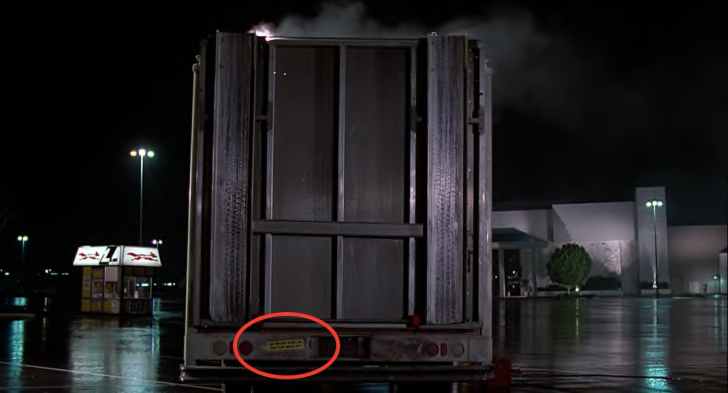16. ZEMECKIS AND GALE MUST LOVE THE NUMBERS ONE AND 21.
When Einstein the dog is sent a minute into the future, his stopwatch indicates that one minute and 20 seconds has elapsed. Einstein also reappears at 1:21a.m. using the 1.21 gigawatts of energy from the Flux Capacitor.
17. DOC’S BUMPER STICKER IS PROPHETIC.
It reads: "One Nuclear Bomb Can Ruin Your Whole Day," which is appropriate since the plot of the movie hinges on stolen plutonium that results in Doc's death. The nuclear reaction needed to generate 1.21 gigawatts really did ruin his day.
18. DOC DROPS A HINT FOR BACK TO THE FUTURE PART II.
During the experiment, Doc tells Marty, "I've always dreamed of seeing the future, looking beyond my years, seeing the progress of mankind. I'll also be able to see who wins the next 25 World Series.”
This ends up being a plot point in the sequel when 1955 Biff strikes it rich with knowledge gained from the Grays Sports Almanac stolen from 2015.
19. DOC’S GUN LOOKS FAMILIAR.
The pearl-handled handgun Doc uses to try to shoot the Libyans in the mall parking lot is the same pistol he uses at the drive-in theater to time Marty’s trip to the old west in Back to the Future Part III. Maybe it jams because it’s a 30-year-old gun?
20. THERE'S A ROCKY AND BULLWINKLE HOMAGE.
His name isn’t said out loud, but Old Man Peabody’s son is credited as “Sherman,” a direct reference to Mr. Peabody and Sherman, the time-traveling cartoon duo from The Adventures of Rocky and Bullwinkle, which first aired in 1959.
21. SHERMAN IS A FAN OF SOME CLASSIC COMIC BOOKS.
The fictional Tales from Space comic book Sherman uses to explain the time machine to his father sports the logo of legendary Tales from the Crypt publisher EC Comics.
22. ROY’S RECORDS DID SOME TIME TRAVELING, TOO.
When Marty drops in on 1955 Hill Valley he first sees Cattle Queen of Montana on the Essex theater marquee, a 1954 film starring Barbara Stanwyck and Ronald Reagan—a great set-up to Doc’s befuddled reaction to the future president a few scenes later. Marty also spots Roy’s Records with four album advertisements in the window.
One is the 1954 reissue of Nat King Cole’s “Unforgettable,” but the other three are anachronisms: The Chordettes’s self-titled compilation wasn’t released until 1959, “Eydie in Dixieland” by Eydie Gorme wasn’t released until 1959, and “In the Land of Hi-Fi” by Patti Page wasn’t released until 1956.
23. HILL VALLEY’S PHONE BOOK NEEDS A COPY EDITOR.
The 1955 phone book spells Doc’s name wrong—it should be Emmett, not “Emmet.” At least they get his occupation right!
24. DOC BROWN LIVES IN AN ARTS AND CRAFTS MASTERPIECE.
Doc’s original house at 1640 Riverside Drive (or John F. Kennedy Drive if it’s 1985) is actually a historic landmark in Pasadena, California called the Gamble House. Designed by architects Charles and Henry Greene for James Gamble of Procter and Gamble fame, it’s a prime example of the Arts and Crafts architectural movement made famous in the late 19th century.
25. DOC'S GARAGE IS OF HISTORICAL IMPORTANCE.
A newspaper clipping in the opening scene says Doc’s mansion somehow mysteriously burned down and the surrounding land was sold off, which is why he’s resorted to living in the property’s old garage at 1646 John F. Kennedy Drive in 1985.
Later, Doc tells Marty, “It's taken me almost 30 years and my entire family fortune to realize the [time machine],” so we can infer that Doc, along with the proceeds from selling off the surrounding land, burned down his mansion to collect the insurance money to fund the creation of time machine.
26. DOC KEEPS HIS MENTORS CLOSE.
The same framed photos of Albert Einstein, Isaac Newton, Ben Franklin, and Thomas Edison above Doc Brown’s mantel in 1955 can be seen above his bed in the retrofitted garage bungalow in 1985.
https://www.mentalfloss.com/article/549729/back-to-the-future-things-to-look-for-mistakes  UNIVERSAL PICTURES HOME ENTERTAINMENT
UNIVERSAL PICTURES HOME ENTERTAINMENT
